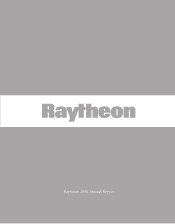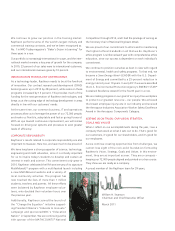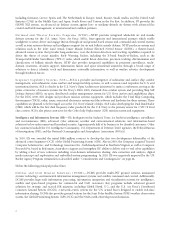Raytheon 2010 Annual Report Download - page 11
Download and view the complete annual report
Please find page 11 of the 2010 Raytheon annual report below. You can navigate through the pages in the report by either clicking on the pages listed below, or by using the keyword search tool below to find specific information within the annual report.Ground Enterprise Solutions (GES)—GES primarily supports classified programs in support of the U.S.
Intelligence Community. GES capabilities include ground systems for Geospatial Intelligence (GEOINT) and Signals
Intelligence (SIGINT) systems, large-scale data processing and exploitation, storage architectures and high performance
data handling and processing systems.
Mission Operations Solutions (MOS)—MOS provides integrated mission support and systems engineering for
civil, intelligence and defense agencies, as well as international governments. Its scalable, secure and integrated business
systems are focused on delivering enterprise-wide performance improvement and reliable results. Core competencies
include business excellence, mission critical operations, mission systems engineering, enterprise solutions and
infrastructure services.
Operational Technologies and Solutions (OTS)—OTS provides cutting-edge management and
dissemination of massive volumes of intelligence data, as well as intelligence operations support capabilities for Human
Intelligence (HUMINT), Open Source Intelligence (OSINT), wireless and close access collection for intelligence, law
enforcement and other government agencies. OTS also has strong capabilities in geospatial, geologic and technical
analysis and support.
Information Security Solutions (ISS)—ISS is focused on providing information security solutions and services
to government and Fortune 500 customers worldwide. Through ISS, Raytheon combines its legacy information assurance
solutions with a number of products from recent key acquisitions to provide leading cybersecurity offerings, including
Active Defense—protecting mission critical systems against a wide range of internal and external threats. ISS capabilities
are used to counter sophisticated and dangerous advanced persistent threats in the world. In addition to expanding in
information assurance and cyber-operations areas, Raytheon is leveraging and incorporating the cyber-capabilities within
ISS broadly across the company, embedding information assurance technologies and know-how into many of its core
solutions and products. ISS provides high-level cyber security support to the Defense Intelligence Systems Agency on the
Insider Threat Focused Observation Tool program and manages information assurance for the National Geospatial
Intelligence Agency.
Advanced Programs (AP)—AP is focused on providing innovative solutions for a new generation of special
missions. It applies advanced technology to address complex problems for U.S. intelligence and operational commands.
Missile Systems (MS)—MS, headquartered in Tucson, Arizona is a premier developer and producer of missile systems
for the armed forces of the U.S. and other allied nations. Leveraging its key capabilities in advanced airframes, guidance
and navigation systems, high-resolution sensors, targeting, and netted systems, MS develops and supports a broad range
of cutting-edge weapon systems, including missiles, smart munitions, close-in weapon systems, projectiles, kinetic kill
vehicles and directed energy effectors. Key customers include the U.S. Navy, Army, Air Force and Marine Corps, the
MDA and the armed forces of more than 40 allied nations.
In 2010, MS continued to demonstrate its missile systems capabilities with several key contract awards and significant test
successes. MS won a $450 million contract to launch development of the Small Diameter Bomb Increment II (SDB II) for
the U.S. Air Force and Navy. The U.S. Army selected MS as the winner for the next phase of the Excalibur Ib program:
the next-generation, 155 mm, precision-guided projectile. MS continued to gain key contract awards from a broad
international customer base, including more than $600 million in international awards for the PavewayTM program and
more than $250 million for the Advanced Medium-Range Air-to-Air Missile (AMRAAM) program. In addition, the
Standard Missile-3 (SM-3) program had another successful flight test. SM-3 is a key element of the U.S. Government’s
missile defense strategy. MS also completed the risk reduction phase of the Joint Air-to-Ground Missile (JAGM) with
several key flight test successes demonstrating the tri-mode seeker. MS and Boeing are partnering on the JAGM program,
which will be a competitively awarded program intended to replace Hellfire, Maverick and air-launched TOW missiles.
MS has the following principal product lines:
Air Warfare Systems (AWS)—AWS products and services enable the U.S. armed forces and international
customers to attack, suppress and destroy air- and ground-based targets. Products include the AMRAAM, a
state-of-the-art, highly dependable and battle-proven air-to-air missile that also has a surface-to-air launch application;
the Tomahawk cruise missile, an advanced surface- or submarine-launched cruise missile with loitering and network
3
























